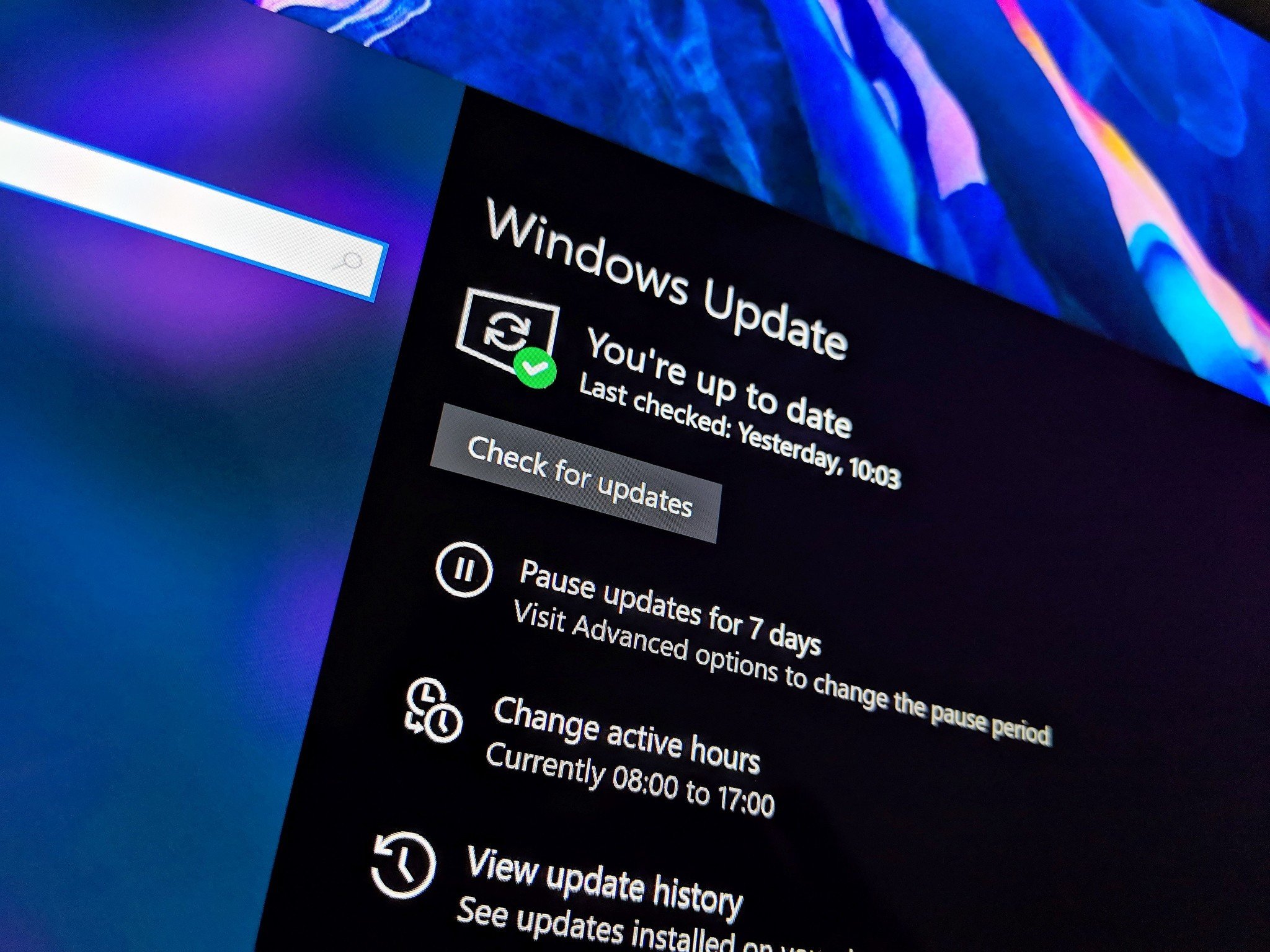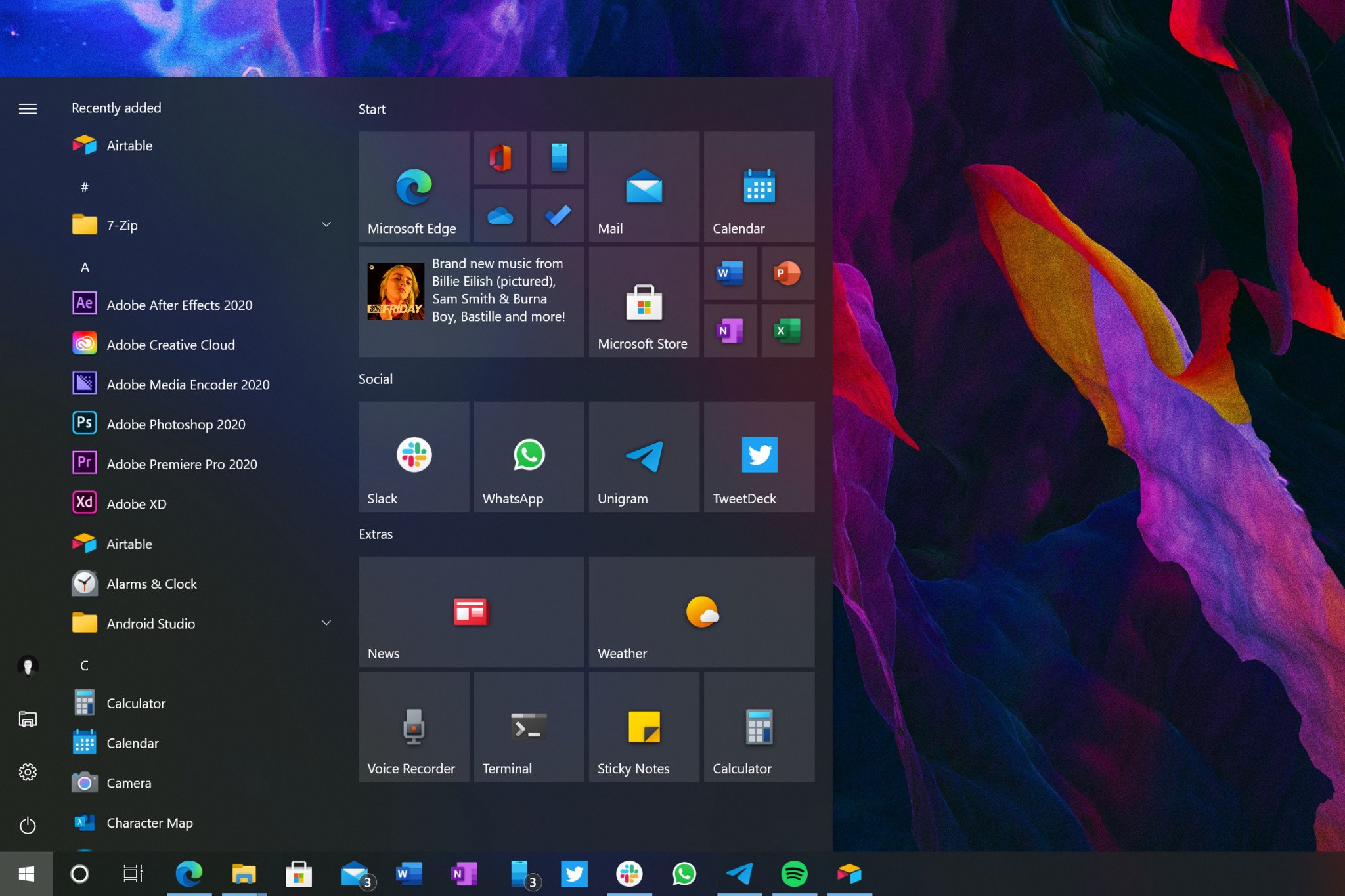Windows 10 version 20H2: The complete changelog
News
By
Zac Bowden
last updated
Keep up with the latest changes introduced with Windows 10 version 20H2.

Microsoft has released the next version of Windows 10, known as version 20H2 and featuring new changes and enhancements. Here's a convenient list detailing everything new in the update.
Just like the Windows 10 November 2019 Update, this upcoming release isn't a full feature update. That means when it's ready, the update will sit on top of the May 2020 Update instead, equating to a much smaller download and install period.
OS Details
- Public name: Windows 10 October 2020 Update
- Codename: N/A
- Version: 20H2
- Build: 19042
- Released: October 2020
Version 20H2 changelog
Windows Shell

- The Start menu now has a streamlined design that removes solid color backplates behind app logos in the apps list and live tile interface.
- Tabs in Microsoft Edge will now show up in the ALT+TAB interface.
- Pinned websites will now show all open instances when hovering over its icon on the taskbar.
- Notifications feature an updated layout with an X to dismiss notifications back into the Action Center.
Windows Settings
- System > About now features copy buttons that will copy your system specifications to your clipboard.
- There's a new Local Users and Groups modern device management (MDM) policy that allows an administrator to make granular changes to a local group on a managed device, on par with what has been available to devices managed with on-prem Group Policy (GP).
Miscellaneous changes
- The new Microsoft Edge is now preinstalled.
- The touch experience is more optimized when in desktop mode.
- Focus Assist will no longer provide users with a summary of missed notifications when Focus Assist is turned off.
- Using your Microsoft Account, Windows 10 will now automatically pin Your Phone, Office, or the Xbox app to the Taskbar when setting up a PC running 20H2 for the first time.
- Improved support for non-ASCII file paths for Microsoft Defender Advanced Threat Protection (ATP) Auto Incident Response (IR).
Fixes
- Fixed an issue that causes error messages to display in the English US (en-US) language instead of in the non-English language you selected. This occurs when you install a non-English language pack before installing the latest cumulative update.
- Fixed the toast notification that appears at restart when you update from Windows 10, version 2004.
- Fixed an issue that causes non-English strings to disappear, which might affect the text on the tiles of the Start menu.
- Fixed an issue that prevents you from using sharing functionality in Microsoft Office. This occurs when Conditional Access is enabled.
- Fixed an issue that occurs when a third-party application loads hidden tabs into Internet Options.
- Fixed an issue in Microsoft Edge IE mode that occurs when you open multiple documents from a SharePoint site.
- Fixed an issue in Microsoft Edge IE mode that occurs when you browse using anchor links.
- Fixed an issue with pasting mixed content of images and text from Microsoft Word into Internet Explorer.
- Fixed an issue that might cause Microsoft browsers to incorrectly bypass proxy servers.
- Fixed an issue in the Windows Push Notification (WNS) service that prevents you from selecting a virtual private network (VPN) interface to make outbound connections. As a result, you lose connectivity with the WNS service when forced tunneling is used.
- Fxed an issue that might cause the Magnifier to stop working in Microsoft Excel in certain scenarios. As a result, Microsoft Excel might also stop working.
- Fxed an issue that prevents you from installing some .msi apps. This occurs when a device is managed by a Group Policy that redirects the AppData folder to a network folder.
- Fixed an issue that might display 4K high dynamic range (HDR) content darker than expected when you configure certain non-HDR systems for HDR Streaming.
- Fixed an issue that causes new child windows to flicker and appear as white squares on server devices that are configured for stark visual contrast.
- Fixed an issue that causes the Settings page to close unexpectedly, which prevents default applications from being set up properly.
- Fxed an issue that causes all open Universal Windows Platform (UWP) apps to close unexpectedly. This occurs when their installer calls the Restart Manager to restart File Explorer (explorer.exe).
- Fixed an issue that prevents Windows 8.1 apps from projecting to a secondary display when those apps use the StartProjectingAsync API.
- Fixed an issue that prevents family safety features, such as time limits and activity reporting, from working on ARM64 devices.
- Fixed an issue with File Explorer's preview of .msg files when Microsoft Outlook 64-bit is installed.
- Fixed an issue that causes a KERNEL_SECURITY_CHECK_FAILURE (139) stop error when Windows resumes from Sleep and turns on certain Bluetooth headsets.
- Fixed an issue that might prevent certain display driver reset utilities from properly reinstalling the same driver on the system.
- Fixed a reliability issue in WDF01000.sys.
- Fixed an issue that causes memory leaks when an application calls the CryptCATAdminCalcHashFromFileHandle() function. The leaked memory is reclaimed when the application closes.
- Fixed an issue that prevents some machines from automatically going into Sleep mode under certain circumstances because of Microsoft Defender ATP Auto IR.
- Fixed an issue that prevents some machines from running Microsoft Defender ATP Threat & Vulnerability Management successfully.
- Fixed an issue that prevents Microsoft Defender ATP from applying file exclusions in some cases, which leads to application compatibility issues.
- Fixed an issue in Microsoft Defender ATP that prevents some machines from reporting the installed applications to Threat & Vulnerability Management.
- Fixed an issue that causes automatic investigations to fail in Microsoft Defender ATP.
- Improves Microsoft Defender ATP's ability to identify malicious code injection activities.
- Fixed an issue that prevents some applications from printing to network printers.
- Fixed an issue that might cause a printer to be a hidden device in Device Manager after a restart.
- Fixed an issue that might cause the Print Management console to display script errors when you enable the Extended View option.
- Fixed an issue that causes printing to fail in certain scenarios.
- Fixed an issue that might prevent a Windows 10 device from reaching the internet when using a wireless wide area network (WWAN) LTE modem. However, the Network Connectivity Status Indicator (NCSI) in the notification area might still indicate that you are connected to the internet.
- Fixed an issue that might prevent internet connectivity on some cellular modems after upgrading to Windows 10, version 2004.
- Fixed an issue that causes telephony applications to lose the first four digits.
- Fixed an issue with in-memory parity bitmaps that can cause data integrity issues on Parity Storage Spaces.
- Fixed an issue that prevents the creation of a storage pool using Manage Storage Spaces in Control panel.
- Fixed an issue that might cause the Microsoft Remote Assistance process (msra.exe) to stop working when a user is receiving assistance during a computer session. The error is 0xc0000005 or 0xc0000409.
Catch up on all the changes from the previous Windows 10 updates
Seeing a feature that isn't listed here? Perhaps it was added in a previous Windows 10 update. Check out our changelogs for those below!
- Windows 10 19H1 complete changelog
- Windows 10 Redstone 5 complete changelog
- Windows 10 Redstone 4 complete changelog
- Windows 10 Redstone 3 complete changelog
Get the Windows Central Newsletter
All the latest news, reviews, and guides for Windows and Xbox diehards.
CATEGORIES

Senior Editor
LATEST ARTICLES
